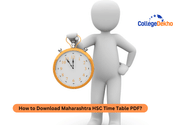

Never Miss an Exam Update
About MBSE HSSLC Syllabus 2025-26
MBSE HSSLC Syllabus 2026: The Mizoram Board of School Education (MBSE) will release the MBSE HSSLC syllabus 2026 on its official website. Once the syllabus is officially published, we will update the latest version here for students' reference. Meanwhile, the MBSE Class 12 syllabus from the previous academic year has been provided, as no major changes are expected this year. If any revisions are introduced, we will update the information accordingly. Students need to note that the MBSE HSSLC exams adhere to the NCERT syllabus framework. Therefore, students appearing for the Mizoram Class 12 board exams should thoroughly review both the MBSE HSSLC syllabus and exam pattern. This will help them identify key topics and understand the examination blueprint.
The syllabus PDF includes the syllabus for all the subjects in the curriculum and all the streams. It will include information about the units and the topics included in the curriculum. Mostly, the theory papers will be conducted for 80 marks and the remaining marks will be allotted for the internal assessment or practical papers. Students must download the syllabus to check the information about the topics that will be covered in the papers. Students must also download the latest
MBSE HSSLC Exam Pattern 2025-26
from the official website of MBSE. Check out more information about the MBSE HSSLC Syllabus 2025-26 here:
MBSE HSSLC Syllabus 2025-26: PDF
Students can download the direct PDF of the MBSE HSSLC Syllabus 2025-26 by clicking on the link given below and start preparing for the exam:
MBSE HSSLC Syllabus 2025-26 for Arts
The MBSE HSSLC Arts syllabus 2025-26 includes core subjects such as History, Geography, Political Science, Psychology, Sociology, and English. Candidates can refer to the detailed syllabus for each subject in the Arts stream to aid in their board exam preparation.
MBSE HSSLC English Syllabus 2025-26
English is one of the main subjects included in the curriculum for class 12th students in Mizoram. Check the syllabus regarding the same from the information given below:
- SECTION – A: READING SKILLS
The total length of the two passages will be between 800- 1000 words. The passages will include two of the following:
(a) Factual Passages e.g. instructions, descriptions, reports.
(b) Discursive passage involving opinion e.g. argumentative, persuasive or interpretative text.
(c) Literary passage e.g. extract from fiction, drama, poetry, essay or biography.
Summary
- SECTION – B: WRITING SKILLS
3. Two short compositions of not more than 50 words each. E.g. Notices and writing formal and informal invitations and replies.
4. Writing one out of two letters based on verbal input. Letter types include.
(a) business or official letters (for making enquiries, registering complaints, asking for and giving information, placing orders and sending replies)
(b) letters to the editor (giving suggestions on an issue)
(c) application for a job.
5. One out of two compositions based on visual and/or verbal input (120 words). Output may be descriptive or argumentative in nature such as an article or a report.
- SECTION – C: LITERATURE TEXT BOOK AND SUPPLEMENTARY
READING TEXT
Questions should assess local and global comprehension, interpretation, analysis, evaluation, inference, appreciation and extrapolation beyond the text, and should elicit inferential responses through critical thinking.
Course Book
6. One out of two extracts on poetry.
7. Three short questions from poetry section.
8. Two multiple choice questions from prose section.
9. Four short answer type questions based on the prose section.
10. One out of two long answer type question from prose section.
Supplementary Reader
11. Three short answer type questions.
12. Four multiple choice questions.
13. One out of two long answer type questions.
MBSE HSSLC Political Science Syllabus
The MBSE HSSLC Political Science syllabus 2025-26 is divided into two main sections. Students can refer to the detailed syllabus below for the current academic year to guide their preparation effectively.| Unit | Unit Name |
| Part A - Contemporary World Politics | |
| I | Cold War Era in World Politics 2. Disintegration of Second World and the collapse of Bipolary |
| II | US dominance in World Politics 2. Alternative centres of Economic and Political Power |
| III | International Organisations in a Unipolar World |
| Part B - Politics in India since Independence | |
| V |
Nation Building and its Problems
Era of One-Party Dominance |
| VI | India’s External Relations |
| VII | Crisis of the Constitutional Order 2. Regional Aspirations and Conflicts |
MBSE HSSLC Syllabus for History
Find below the MBSE HSSLC history syllabus for the academic year 2025-26:
| Unit | Unit Name |
| I |
BRICKS, BREADS AND BONES, The Harappan Civilisation, KINGS, FARMERS AND TOWNS
Early States and Economies, KINSHIP, CASTE AND CLASS, Early Societies (c. 600BCE - 600CE) |
| II |
BHAKTI — SUFI TRADITIONS, Changes in Religious Beliefs and Devotional Texts (c. eighth to eighteenth centuries), IMPERIAL CAPITAL: VIJAYANAGARA
(c. fourteenth to sixteenth centuries), PEASANTS, ZAMINDARS AND THE STATE, and Agrarian Society and the Mughal Empire. |
| III | COLONIALISM AND COUNTRYSIDE, Exploring the Official Archives, REBELS AND RAJ, 1857 Revolt and its Representations, MAHATMA GANDHI AND THE NATIONALIST MOVEMENT, and Civil Disobedience and Beyond. |
| IV | Map Work |
MBSE HSSLC Syllabus for Geography
Students are encouraged to follow the MBSE HSSLC Geography syllabus 2025-26 and plan their exam preparation accordingly. Below is the detailed syllabus along with the marks distribution for Geography for the current academic year.
| Units | Unit Name |
| Part A - Fundamentals of Human Geography | |
| I |
Chapter 1. Human Geography – Nature and Scope
a) Introduction and definition (p-3) b) Nature of Human Geography c) Scope of Human Geography d) Approaches: Traditional Approaches to Human Geography (p-6) |
| II |
Population
Chapter 2. Population of the world – Number, Growth and Density a) Growth of the world population b) Factors of increase in world population c) Distribution of world population d) Factors affecting population distribution and density – an overall viewpoint Chapter 3. Population change a) Introduction b) determinants of population change c) Fertility & its measures d) Mortality & its measures e) Migration f) Factors determining migration Chapter 4: Human development a) Introduction b) HD: Selected indicators |
| III |
Human Activities
Chapter 5 : Human Activities a) Primary activities – gathering, pastoralism, mining, minerals, subsistence agriculture, Modern agriculture, Major crops – Rice, Wheat, Beverages – tea, coffee. Fiber crops - Cotton |
| IV |
Transport, Communication and Trade
Chapter 6 : transport and communication a) Modes of transport – Roadways, Railways, pipelines, Water transport, Air transport b) Mass communication, Computer Networking and Uses Chapter 7 : International trade a) Basis of International trade, recent trends in International trade and ports. |
| V |
Human Settlements
Chapter 8: Human Settlements Types of settlements, rural settlement patterns, classification of towns, or on the basis of size, urban land use structure, functional classification of towns and problems of human settlements in developing countries |
| VI | Map work (related to Unit 1-5) |
| Part B - People and Economy | |
| I |
People
Chapter 9 : Population composition: Ethnic and Socio-Cultural Attributes a) Tribal population, State-wise distribution. b) Spatial distribution of scheduled caste, state-wise distribution of SC c) Language and dialect groups, classification of Indian languages d) Unity in diversity Chapter 10: Population of India: Aspects of spatial distribution and Growth a) General demographic scene in India b) Census of population c) Distribution of population in India – State level d) Variations in the density of the population e) Trends in population growth in India f) Variations in population growth g) Migration trends in India Chapter 11: Population Composition: Demographic Attributes -Whole Chapter Chapter 13: Population, Environment and Development a) Population growth and environments b) Agricultural development and environmental degradation c) Urbanization and environmental degradation |
| II |
Human Settlements
Chapter 14: Human Settlements and House Types - Settlements, table indicating differences between urban and rural settlements, the morphology of an Indian town, House type |
| III |
Resources and Sustainable Development
Chapter 18: Planning in India and the Need for Sustainable Development
|
| IV |
Transport, Communication and International Trade
Chapter 19: Transport Systems - Rail transport, progress of Indian Railways, factors, distribution of Indian railways, Railway zones - Road transport and classification of roads - Inland waterways, problems, air transport, and pipelines - Power grid Chapter 20: International trade, Seaports and Airports - Nature of Indian foreign trade; present picture, Scope of Export - Seaports - Airports |
| V |
Geographical perspective on Selected issues and problems
Chapter 21: Geographical perspective on Selected issues and problems - Environmental pollution – air, and water pollution - Hunger and poverty – causes - Urbanization, Urban waste disposal |
| VII | Map work (related to Part B Unit 1-5) |
MBSE HSSLC Syllabus 2025-26 for Science
The MBSE HSSLC syllabus 2025-26 for the Science stream includes essential subjects such as Physics, Chemistry, Biology, and Mathematics. Students are advised to go through the subject-wise syllabus details provided below to gain a clear understanding of the topics covered. Referring to the updated syllabus will help students prepare effectively for the upcoming board examinations.
MBSE HSSLC Mathematics Syllabus 2025-26
The unit-wise breakdown and marks distribution for the MBSE HSSLC Mathematics syllabus 2025-26 are provided below. Students can refer to the details to understand the structure of the syllabus and prepare accordingly for the academic year 2025-26.
| Unit | Unit Name |
| I | Relations and Functions |
| II | Algebra |
| III | Calculus |
| IV | Vector and Three-Dimensional Geometry |
| V | Linear Programming |
| VI | Probability |
MBSE HSSLC Physics Syllabus 2025-26
Students can plan and streamline their Physics preparation by referring to the details provided below. Find the MBSE HSSLC Physics syllabus 2025-26 for the current academic year outlined below:
| Unit No. | Unit Name |
|---|---|
| 1 | Electrostatics |
| 2 | Current Electricity |
| 3 | Magnetic Effect of Current & Magnetism |
| 4 | Electromagnetic Induction and Alternating Current |
| 5 | Electromagnetic Waves |
| 6 | Optics |
| 7 | Dual Nature of Matter |
| 8 | Atoms and Nuclei |
| 9 | Electronic Devices |
| 10 | Communication Systems |
MBSE HSSLC Chemistry Syllabus 2025-26
The key topics included in the MBSE HSSLC Chemistry syllabus 2025-26 are crucial for effective exam preparation. Students are advised to study these thoroughly to perform well in the board exams. The detailed syllabus for Chemistry is provided below.
| Unit | Unit Name |
| I |
Solid State
Classification of solids based on different binding forces: molecular, ionic covalent and metallic solids, amorphous and crystalline solids(elementary idea), unit cell in two-dimensional and three-dimensional lattices, calculation of the density of unit cell, packing in solids, packing efficiency, voids, number of atoms per unit cell in a cubic unit cell, point defects.
|
| II |
Solutions
Types of solutions, expression of concentration of solutions of solids in liquids, the solubility of gases in liquids, solid solutions, colligative properties — relative lowering of vapor pressure, Raoult’s law, the elevation of B.P.,depression of freezing point osmotic pressure, determination of molecular masses using colligative properties. |
| III |
Electrochemistry
Redox reactions, conductance in electrolytic solutions, specific and molar conductivity variations of conductivity with concentration, Kohlrausch’s Law, electrolysis, EMF of a cell, standard electrode potential, Nernst equation and its application to chemical cells. Relation between Gibbs energy change and EMF of a cell. |
| IV |
Chemical Kinetics
Rate of a reaction (average and instantaneous), factors affecting rates of reaction: concentration, temperature, catalyst; order and molecularity of a reaction; rate law and specific rate constant, integrated rate equations, and half life (only for-zero and first-order reactions). |
| V |
Surface Chemistry
Adsorption — physisorption, and chemisorption; factors affecting adsorption of gases on solids; colloidal state; distinction between true solutions, colloids and suspensions; lyophilic, lyophobic multi molecular, and macromolecular colloids; properties of colloids; Tyndall effect, Brownian movement, electrophoresis, and coagulation. |
| VII |
p-Block Elements
Group 15 element: General introduction, electronic configuration, occurrence, oxidation states, and trends. in physical and chemical properties; nitrogen — preparation, properties, and uses; compounds of nitrogen: preparation and properties of ammonia and nitric acid. Group 16 elements: General introduction, electronic configuration, oxidation states, occurrence, and trends in physical and chemical properties; dioxygen, properties and uses; classification of oxides; ozone. Sulphur — allotropic forms; compounds of sulfur: preparation, properties, and uses of sulfur dioxide, properties, and uses, oxoacids of sulfur (structures only). Group 17 elements: General introduction, electronic configuration, oxidation states, occurrence, and trends in physical and chemical properties; compounds of halogens: preparation, properties, and uses of chlorine and hydrochloric acid, interhalogen compounds, oxoacids of halogens (structure only). Group 18 elements: General introduction, electronic configuration, occurrence, trends in physical and chemical properties, and uses. |
| VIII |
d -and f- Block Elements
General introduction, electronic configuration, occurrence and characteristics of transition metals, general trends in properties of the first row transition metals – metallic character, ionization enthalpy, oxidation states, ionic radii, color, catalytic property, magnetic properties, interstitial compounds, alloy formation. Lanthanoids - electronic configuration, oxidation states, contraction and its consequences. |
| IX |
Coordination Compounds
Coordination compounds: Introduction, ligands, coordination number, color, magnetic properties, and shapes, IUPAC nomenclature of mononuclear coordination compounds, bonding, Werner’s theory VBT, CFT. |
| X |
Haloalkanes and Haloarenes
Haloalkanes: Nomenclature, nature of C-X bond, physical and chemical properties, mechanism of substitution reactions. Optical rotation. Haloarenes: Nature of C-X bond, substitution reactions (directive influence of halogen for monosubstituted compounds only) |
| XI |
Alcohols, Phenols and Ethers
Alcohols: Nomenclature, methods of preparation, physical and chemical properties (of primary alcohols only); identification of primary, and secondary and tertiary alcohols, mechanism of dehydration. Phenols: Nomenclature, methods of preparation, physical and chemical properties, acidic nature of phenol, electrophilic substitution reactions, uses of phenols. Ethers: Nomenclature, methods of preparation, physical and chemical properties, uses. |
| XII |
Aldehydes, Ketones and Carboxylic Acids
Aldehydes and Ketones: Nomenclature, nature of carbonyl group, methods of preparation, physical and chemical properties, and mechanism of nucleophilic addition, reactivity of alpha hydrogen in aldehydes; uses. Carboxylic Acids: Nomenclature, acidic nature, methods of preparation, physical and chemical properties; uses. |
| XIII |
Organic Compounds Containing Nitrogen
Amines: Nomenclature, classification, structure, methods of preparation, physical and chemical properties, uses, identification of primary secondary and tertiary amines. Cyanides and Isocyanides – will be mentioned at relevant places in context. |
| XIV |
Biomolecules
Carbohydrates - Classification (aldoses and ketoses), monosaccharide (glucose and fructose), DL configuration Proteins - Elementary idea of a-amino acids, peptide bond, polypeptides, proteins, primary structure, secondary structure, tertiary structure and quaternary structure (qualitative idea only), denaturation of proteins. Nucleic Acids: DNA and RNA |
MBSE HSSLC Syllabus 2025-26 for Commerce
The Commerce stream consists of core subjects like Accountancy, Business Studies, Economics, Mathematics, and English. Kindly go through the given syllabus and study accordingly.
MBSE HSSLC Economics Syllabus 2025-26
Find below the MBSE HSSLC Syllabus 2025-26 for Economics:
| Unit | Unit Name |
| Part A - Macroeconomics | |
| 1 |
Introduction:
Macroeconomics:The major problems it addresses are growth, inflation, and employment. The Business Cycle, Aggregate Demand, Aggregate Supply, Consumption Goods, Capital Goods, Final Goods, Intermediate Goods, Stocks and Flows: Gross Investment, and Depreciation are some fundamental macroeconomic concepts. |
| 2 | National Income and related Aggregate :Circular flow of income, the calculation of N.I., and notions of aggregates connected to N.I. include the basic concepts of GNP, NNP, gross and net domestic product (GDP & NDP) at market price, at factor cost, and national disposable income (gross and net). |
| 3 | Theory of Income and employment ―Consumption function and investment function, propensity to consume and propensity to save, equilibrium output, and aggregate demand and its composites. |
| 4 | Money and Banking : Money — Types, meaning, and functions. Currency held by the general public and net demand deposits held by commercial banks make up the supply of money. Commercial banks also create money and credit in this capacity. Central Bank: Definitions and Purposes. |
| 5 |
Monetary policy, Fiscal policy and Govt. budget ― Fiscal Policy – meaning, types and tools ― Government Budget – meaning, objectives, components and types.
classification of expenditures – revenue expenditure and capital expenditures. Various measures of govt. deficit – revenue deficit, fiscal deficit, primary deficit: their meaning and implications. |
| Part B - Indian Economic Development | |
| 6 | Introduction : Parameter of development – per capita income, HDI in India ― Main features, problems and policies of agriculture and foreign trade. |
| 7 | Planning and Economic development in India : Objectives, Targets, Achievements and drawbacks of different Five Year Plans in India (A brief account). |
| 8 | Structural change in the Indian Economy after Liberalization : Liberalisation, globalisation, disinvestment, and privatisation: their purpose, importance, and characteristics. Current Economic Features of India. |
| 9 | A critical appraisal, rural development, and poverty (both absolute and relative) are among the current concerns facing the Indian economy. Credit and marketing: The cooperative's role in Agriculture diversification includes: alternative and organic farming; human capital building; the importance of human capital in economic development; and sustainable economic growth, which refers to the impact of economic development on the environment and resources. |
| 10 | Economic growth and development: A comparison of India and China on the following indicators reveals the meaning and differences of these terms. i) Joblessness GDP growth, GDP per capita, GDP purchasing power parity, amount of direct foreign investment, inflation, and poverty are among the other factors. |
MBSE HSSLC Business Studies Syllabus 2025-26
Students can check out the information about the Business Studies syllabus from the table given below:
Unit | Topics |
|---|---|
Unit 1: Nature and Significance of Management | - Management: Concept, Objective, Importance - Management as a Science, Art, or Profession - Levels of Management - Management Functions: Planning, Organising, Staffing, Directing and Controlling - Coordination: Characteristics and Importance |
Unit 2: Principle of Management | - Principles of Management: Concept and Significance - Fayol’s Principles of Management - Taylor’s Scientific Management: Principles and Techniques - Comparison between contributions of Fayol and Taylor |
Unit 3: Business Environment | - Business Environment: Concept and Importance - Dimensions of Business Environment: Economic, Social, Technological, Political, and Legal - Demonetization: Concept and Features |
Unit 4: Planning | - Concept, Importance, Limitations - Planning Process - Types of Plans: Concepts of Objectives, Strategies, Policies, Procedures, Methods, Rules, Budget and Programme |
Unit 5: Organising | - Concept and Importance - Steps in the Process of Organising - Structure of Organisation: Functional and Divisional - Concept and Differences - Formal and Informal Organisation: Concept and Differences - Delegation: Concept, Elements and Importance - Decentralization: Concept and Importance - Difference between Delegation and Decentralization |
Unit 6: Staffing | - Concept and Importance of Staffing - Staffing as a Part of Human Resource Management - Staffing Process: Steps in the Process - Recruitment: Meaning and Sources - Selection: Meaning and Steps - Training and Development: Concept, Importance, Differences, Methods of Training (On the Job, Off the Job, Vestibule, Apprenticeship, Internship) |
Unit 7: Directing | - Concept and Importance - Elements of Directing: Motivation (Concept, Maslow’s Hierarchy of Needs), Financial and Non-Financial Incentives, Leadership (Concept, Styles - Authoritative, Democratic, Laissez Faire), Communication (Concept, Formal and Informal Communication, Barriers to Effective Communication, How to Overcome Barriers) |
Unit 8: Controlling | - Concept and Importance - Relationship between Planning and Controlling - Steps in the Process of Control |
Unit 9: Financial Management | - Concept, Objective, and Role of Financial Management - Investment, Financing, and Dividend Decisions: Meaning and Factors Affecting - Financial Planning: Concept and Importance - Capital Structure: Concept and Factors Affecting - Fixed and Working Capital: Concept and Factors Affecting its Requirements |
Unit 10: Financial Markets | - Financial Markets: Concept - Money Market: Concept - Capital Market (Primary and Secondary): Meaning and Differences - Stock Exchange: Meaning, Functions, Trading Procedure (Depository Services & Demat Account: Meanings Only) - Securities Exchange Board of India (SEBI): Objectives and Functions |
Unit 11: Marketing Management | - Marketing: Meaning, Functions, Features - Marketing Management Philosophies - Marketing Mix: Concept - Product: Branding, Labeling, Packaging - Price: Concept and Factors Determining Price - Physical Distribution: Concept, Components, Channels of Distribution - Promotion: Advertising, Sales Promotion, Public Relations, Personal Selling |
Unit 12: Consumer Protection | - Concept and Importance - Consumer Protection Act 2019: Scope, Concept of a Consumer, Rights and Responsibilities of a Consumer, Who can File a Complaint, Legal Redressal Machinery, Remedies Available - Consumer Awareness: Role of Consumer Organizations and NGOs |
MBSE HSSLC Accountancy Syllabus 2025-26
Students can check out the information about the MBSE HSSLC Accountancy Syllabus 2025-26 from the table given below:
Unit | Topics |
|---|---|
Unit 1: Accounting for Partnership Firms | - Partnership: Features, Partnership Deed - Provisions of the Indian Partnership Act 1932 in the absence of a partnership deed - Fixed vs Fluctuating Capital Accounts, Preparation of Profit and Loss Appropriation Account: Division of Profit among Partners, Guarantee of Profits - Past Adjustments: Interest on Capital, Interest on Drawing, Salary and Profit Sharing Ratio - Goodwill: Meaning, Nature, Factors Affecting and Methods of Valuation (Average Profit, Super Profit, Capitalization) - Change in Profit Sharing Ratio among Existing Partners: Sacrificing and Gaining Ratio, Revaluation of Assets, Reassessment of Liabilities, Treatment of Reserves, Accumulated Profits, Losses, Revaluation Account, Balance Sheet - Admission of a Partner: Change in Profit Sharing Ratio, Goodwill Treatment (AS 26), Revaluation of Assets, Adjustment of Capital Accounts, Balance Sheet - Retirement and Death of a Partner: Change in Profit Sharing Ratio, Goodwill Treatment (AS 26), Adjustment of Accumulated Profits and Reserves, Capital Accounts, Loan Account of the Retiring Partner - Dissolution of Partnership Firm: Meaning, Types, Settlement of Accounts, Preparation of Realization Account, Capital Accounts, and Cash/Bank Account |
Unit 2: Accounting for Companies | Accounting for Share Capital - Features and Types of Companies - Share and Share Capital: Nature and Types - Issue and Allotment of Equity and Preference Shares: Public Subscription, Over/Under Subscription, Issue at Par or Premium, Calls in Advance and Arrears - Private Placement, Employee Stock Option Plan (ESOP), Sweat Equity - Forfeiture and Reissue of Shares - Disclosure of Share Capital in the Balance Sheet (As per Schedule III of the Companies Act, 2013) Accounting for Debentures - Debentures: Meaning, Types, Issue at Par, Premium, Discount - Issue for Consideration Other than Cash - Redemption Terms, Debentures as Collateral Security, Interest on Debentures (Excluding TDS), Writing Off Discount/Loss on Issue of Debentures |
Unit 3: Analysis of Financial Statements | - Financial Statements of a Company: Meaning, Nature, Uses, and Importance - Statement of Profit and Loss and Balance Sheet (As per Schedule III to the Companies Act, 2013) - Financial Statement Analysis: Meaning, Objectives, Importance, Limitations - Tools for Financial Statement Analysis: Comparative Statements, Common Size Statements, Ratio Analysis, Cash Flow Analysis Accounting Ratios - Liquidity Ratios: Current Ratio, Quick Ratio - Solvency Ratios: Debt to Equity Ratio, Total Asset to Debt Ratio, Proprietary Ratio, Interest Coverage Ratio, Debt to Capital Employed Ratio - Activity Ratios: Inventory Turnover Ratio, Trade Receivables Turnover Ratio, Trade Payables Turnover Ratio, Fixed Asset Turnover Ratio, Net Asset Turnover Ratio, Working Capital Turnover Ratio - Profitability Ratios: Gross Profit Ratio, Operating Ratio, Net Profit Ratio, Return on Investment |
Unit 4: Cash Flow Statement | - Meaning, Objectives, Benefits, Cash and Cash Equivalents - Classification of Activities and Preparation (As per AS 3 Revised, Indirect Method Only) |
Are you feeling lost and unsure about what career path to take after completing 12th standard?
Say goodbye to confusion and hello to a bright future!

FAQs
Students can gain in-depth knowledge of all subjects, get introduced to the exam pattern, and solve various previous year question papers to score well in the MBSE HSSLC Board 2025-26.
Students can complete the MBSE HSSLC Syllabus 2025-26 in advance. They can revise the syllabus and solve the previous year's question papers. Regular practice will help students to score good marks.
Students must start preparing the MBSE HSSLC Syllabus 2025-26 from day one. Students can divide the syllabus into smaller units and prepare a timetable.
Yes, students can visit the official website at mbse.edu.in/ to download the MBSE HSSLC Syllabus 2025-26. After going through the syllabus, students can make a study plan.
Was this article helpful?



















